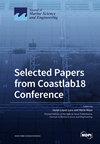基于复杂海面环境下服务半径检测模式的 AIS 基站可信度监测方法
IF 2.7
3区 地球科学
Q1 ENGINEERING, MARINE
引用次数: 0
摘要
自动识别系统 (AIS) 利用基站来管理船只交通和传播水道信息。这些基站使用甚高频信号向其服务半径内的船只广播海上安全数据。然而,"欺骗基站 "的出现对海上安全构成了重大威胁。这些冒牌基站模仿合法的 AIS 基站,盗用其海事移动服务标识 (MMSI) 信息,与船只互动,可能导致错误的决策,或引导船只进入危险区域。因此,确保 AIS 基站的可信度对船舶安全航行至关重要。要实现这一目标,必须区分真正的 AIS 基站和 "欺骗基站"。识别 AIS 欺骗的一个标准是检测超出 AIS 基站预期服务半径的信号。本文提出了一种通过服务半径检测模式监测 AIS 基站可信度的方法。此外,该方法还分析了复杂海面环境中水文和气象因素对 AIS 信号传播的影响。通过整合经验数据,准确描述数学关系,计算出 AIS 基站信号的服务半径。通过分析船只位置坐标、解码基站位置信息、计算船只与 AIS 基站之间的距离,可以与 AIS 基站指定的服务半径和传播距离相匹配。这种方法可精确识别 AIS 欺骗基站,从而促进对 AIS 基站可信度的有力监控。研究成果为在综合海事导航和信息系统内开发高可信度 AIS 基站服务提供了一个基础框架。本文章由计算机程序翻译,如有差异,请以英文原文为准。
An AIS Base Station Credibility Monitoring Method Based on Service Radius Detection Patterns in Complex Sea Surface Environments
The Automatic Identification System (AIS) utilizes base stations to manage vessel traffic and disseminate waterway information. These stations broadcast maritime safety data to vessels within their service radius using VHF signals. However, the emergence of “spoofing base stations” poses a significant threat to maritime safety. These impostors mimic legitimate AIS base stations by appropriating their Maritime Mobile Service Identity (MMSI) information, interacting with vessels, potentially leading to erroneous decisions, or guiding vessels into hazardous areas. Therefore, ensuring the credibility of AIS base stations is critical for safe vessel navigation. It is essential to distinguish between genuine AIS base stations and “spoofing base stations” to achieve this goal. One criterion for identifying AIS spoofing involves detecting signals beyond the expected service radius of AIS base stations. This paper proposes a method to monitor the credibility of AIS base stations through a service radius detection pattern. Furthermore, the method analyzes the impact of hydrological and meteorological factors on AIS signal propagation in complex sea surface environments. By integrating empirical data, it accurately describes the mathematical relationship and calculates the service radius of AIS base station signals. Analyzing vessel position coordinates, decoding base station position messages, and computing distances between vessels and AIS base stations allows for matching with the AIS base station’s designated service radius and propagation distance. This approach enables precise identification of AIS spoofing base stations, thereby facilitating robust monitoring of AIS base station credibility. The research outcomes provide a foundational framework for developing high-credibility AIS base station services within integrated maritime navigation and information systems.
求助全文
通过发布文献求助,成功后即可免费获取论文全文。
去求助
来源期刊

Journal of Marine Science and Engineering
Engineering-Ocean Engineering
CiteScore
4.40
自引率
20.70%
发文量
1640
审稿时长
18.09 days
期刊介绍:
Journal of Marine Science and Engineering (JMSE; ISSN 2077-1312) is an international, peer-reviewed open access journal which provides an advanced forum for studies related to marine science and engineering. It publishes reviews, research papers and communications. Our aim is to encourage scientists to publish their experimental and theoretical results in as much detail as possible. There is no restriction on the length of the papers. The full experimental details must be provided so that the results can be reproduced. Electronic files and software regarding the full details of the calculation or experimental procedure, if unable to be published in a normal way, can be deposited as supplementary electronic material.
 求助内容:
求助内容: 应助结果提醒方式:
应助结果提醒方式:


